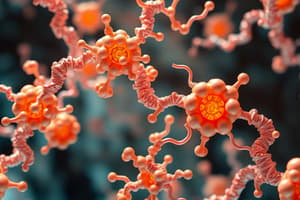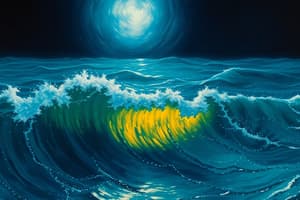Podcast
Questions and Answers
During the Nansen's Fram Expedition, icebergs were observed to drift at an angle to the prevailing wind direction. Which statement offers the most comprehensive explanation for this phenomenon, considering fluid dynamics and geophysical factors?
During the Nansen's Fram Expedition, icebergs were observed to drift at an angle to the prevailing wind direction. Which statement offers the most comprehensive explanation for this phenomenon, considering fluid dynamics and geophysical factors?
- The Coriolis effect induces a deflection to the right (in the Northern Hemisphere), compounded by the Ekman spiral, which describes a depth-dependent decay and directional shift in current velocity due to the balance between the Coriolis force and viscous drag. (correct)
- The drift angle is a stochastic outcome influenced by unpredictable variations in atmospheric pressure and temperature gradients unique to the polar environment.
- The observed drift angle is primarily a result of the conservation of angular momentum within the iceberg itself as it interacts with surface winds.
- The angle of drift is solely determined by the immediate surface wind stress, with icebergs acting as passive drifters responding directly to the applied force.
Consider a scenario where a research vessel is equipped to measure the vertical profile of ocean currents with extremely high precision. If the vessel is located in the Northern Hemisphere, in an open ocean area, and the wind has been blowing consistently from the north for an extended period, what would you anticipate observing in the vertical current profile concerning the Ekman spiral?
Consider a scenario where a research vessel is equipped to measure the vertical profile of ocean currents with extremely high precision. If the vessel is located in the Northern Hemisphere, in an open ocean area, and the wind has been blowing consistently from the north for an extended period, what would you anticipate observing in the vertical current profile concerning the Ekman spiral?
- Random current directions at different depths, showing turbulent mixing dominating over Coriolis and wind-driven effects.
- A uniform current direction with depth, indicating minimal influence from surface winds on deeper water layers.
- A current direction that veers progressively to the right with increasing depth, with the surface current approximately 45 degrees to the right of the wind direction, and a decreasing current speed with depth. (correct)
- A current direction that veers progressively to the left with increasing depth, due to a reversal of the Coriolis effect in deeper waters.
Consider a parcel of water moving along a line of constant latitude in the Northern Hemisphere. Which statement accurately synthesizes the effects of the Coriolis force on this parcel?
Consider a parcel of water moving along a line of constant latitude in the Northern Hemisphere. Which statement accurately synthesizes the effects of the Coriolis force on this parcel?
- The Coriolis force will cause the parcel to accelerate continuously eastward, increasing its velocity without bound.
- There will be no impact from the Coriolis force, as the parcel is moving along a line of constant latitude, thus negating any deflection.
- The Coriolis force will cause the parcel to oscillate north and south around its initial latitude, with no net displacement over time.
- The water parcel will experience a continuous deflection towards the right of its motion, resulting in a curved trajectory unless balanced by another force. (correct)
In the context of large-scale ocean circulation, how do wind patterns and subsequent surface currents fundamentally influence areas of convergence and divergence?
In the context of large-scale ocean circulation, how do wind patterns and subsequent surface currents fundamentally influence areas of convergence and divergence?
Given the interconnected nature of Earth's systems, which statement most accurately describes the multifaceted role of ocean surface currents in global climate regulation?
Given the interconnected nature of Earth's systems, which statement most accurately describes the multifaceted role of ocean surface currents in global climate regulation?
Assuming a steady-state Ekman layer in the Northern Hemisphere, where the wind stress is uniform and constant, and further assuming that the vertical eddy viscosity is also constant, what can be definitively stated about the net (integrated) water transport within the Ekman layer?
Assuming a steady-state Ekman layer in the Northern Hemisphere, where the wind stress is uniform and constant, and further assuming that the vertical eddy viscosity is also constant, what can be definitively stated about the net (integrated) water transport within the Ekman layer?
Considering a high-resolution ocean model that precisely simulates the vertical structure of ocean currents, what key differences would you expect to observe when comparing the Ekman spiral in a deep, open-ocean setting versus a shallow coastal environment?
Considering a high-resolution ocean model that precisely simulates the vertical structure of ocean currents, what key differences would you expect to observe when comparing the Ekman spiral in a deep, open-ocean setting versus a shallow coastal environment?
In a hypothetical scenario, Earth’s rotation rate is significantly increased. Assuming all other factors remain constant, how would this change most directly impact the magnitude and direction of the Coriolis force, and what would be its subsequent effect on large-scale ocean circulation patterns?
In a hypothetical scenario, Earth’s rotation rate is significantly increased. Assuming all other factors remain constant, how would this change most directly impact the magnitude and direction of the Coriolis force, and what would be its subsequent effect on large-scale ocean circulation patterns?
Considering an idealized ocean basin bounded by a straight coastline along its eastern edge in the Northern Hemisphere, and assuming a spatially uniform wind blowing parallel to the coast (i.e., longshore winds), which process is most likely to induce coastal upwelling, and what oceanographic conditions would result?
Considering an idealized ocean basin bounded by a straight coastline along its eastern edge in the Northern Hemisphere, and assuming a spatially uniform wind blowing parallel to the coast (i.e., longshore winds), which process is most likely to induce coastal upwelling, and what oceanographic conditions would result?
The presented diagrams depict surface wind patterns across the globe. How do these wind patterns interact with the major ocean basins to generate the observed patterns of surface currents, and what primary mechanisms govern the relationship between wind stress and ocean current direction?
The presented diagrams depict surface wind patterns across the globe. How do these wind patterns interact with the major ocean basins to generate the observed patterns of surface currents, and what primary mechanisms govern the relationship between wind stress and ocean current direction?
Considering observed chlorophyll-a concentration distributions, what conclusion can be reliably drawn regarding the relationship between surface gyre dynamics and primary productivity in oceanic ecosystems?
Considering observed chlorophyll-a concentration distributions, what conclusion can be reliably drawn regarding the relationship between surface gyre dynamics and primary productivity in oceanic ecosystems?
What second-order effect primarily modulates the intensity of coastal upwelling systems induced by alongshore winds and offshore Ekman transport in the Northern Hemisphere?
What second-order effect primarily modulates the intensity of coastal upwelling systems induced by alongshore winds and offshore Ekman transport in the Northern Hemisphere?
In the context of the solubility pump mechanism within the ocean carbon cycle, which scenario would most substantially reduce the efficiency of CO2 sequestration in deep ocean waters?
In the context of the solubility pump mechanism within the ocean carbon cycle, which scenario would most substantially reduce the efficiency of CO2 sequestration in deep ocean waters?
Considering the dynamics of anthropogenic CO2 uptake by the ocean over the past century, what feedback loop primarily governs the long-term saturation capacity of the ocean's ability to absorb additional CO2?
Considering the dynamics of anthropogenic CO2 uptake by the ocean over the past century, what feedback loop primarily governs the long-term saturation capacity of the ocean's ability to absorb additional CO2?
How would a substantial reduction in the temperature gradient between the equator and the poles most directly influence global patterns of wind-driven circulation and Ekman transport?
How would a substantial reduction in the temperature gradient between the equator and the poles most directly influence global patterns of wind-driven circulation and Ekman transport?
If the Earth's albedo were to significantly decrease, leading to greater absorption of solar radiation, how would this most directly impact the strength and spatial distribution of the subtropical gyres?
If the Earth's albedo were to significantly decrease, leading to greater absorption of solar radiation, how would this most directly impact the strength and spatial distribution of the subtropical gyres?
In a future scenario where significant geoengineering efforts involve large-scale ocean iron fertilization, what unintended consequence could most severely compromise the ocean's capacity to act as a long-term carbon sink?
In a future scenario where significant geoengineering efforts involve large-scale ocean iron fertilization, what unintended consequence could most severely compromise the ocean's capacity to act as a long-term carbon sink?
Considering the interplay between Ekman transport and thermohaline circulation, which perturbation would most dramatically alter the nutrient supply to the euphotic zone in the North Atlantic, thereby affecting regional primary productivity?
Considering the interplay between Ekman transport and thermohaline circulation, which perturbation would most dramatically alter the nutrient supply to the euphotic zone in the North Atlantic, thereby affecting regional primary productivity?
What specific alteration within the mesopelagic zone would most profoundly impair the efficiency of the biological carbon pump, thereby diminishing long-term carbon sequestration in the deep ocean?
What specific alteration within the mesopelagic zone would most profoundly impair the efficiency of the biological carbon pump, thereby diminishing long-term carbon sequestration in the deep ocean?
Considering the information provided regarding ocean garbage patches, what intervention would most effectively address the long-term accumulation of microplastics within subtropical gyres, assuming current technological constraints?
Considering the information provided regarding ocean garbage patches, what intervention would most effectively address the long-term accumulation of microplastics within subtropical gyres, assuming current technological constraints?
Flashcards
Ocean Circulation
Ocean Circulation
The movement of ocean waters driven by wind, density differences, and the Coriolis effect.
Ocean Surface Currents
Ocean Surface Currents
Surface currents are primarily driven by wind patterns and modified the Coriolis Effect.
Iceberg Drift Observation
Iceberg Drift Observation
Observation during Nansen's Fram Expedition that icebergs drift at an angle (20°-40°) to the right of the prevailing wind.
Coriolis Force
Coriolis Force
Signup and view all the flashcards
Ekman Spiral
Ekman Spiral
Signup and view all the flashcards
Ocean Wind Patterns
Ocean Wind Patterns
Signup and view all the flashcards
Trade Winds
Trade Winds
Signup and view all the flashcards
Westerlies
Westerlies
Signup and view all the flashcards
Wind Pressure
Wind Pressure
Signup and view all the flashcards
Ekman Transport
Ekman Transport
Signup and view all the flashcards
Coastal Upwelling System
Coastal Upwelling System
Signup and view all the flashcards
Ekman Downwelling
Ekman Downwelling
Signup and view all the flashcards
Salinity
Salinity
Signup and view all the flashcards
Thermohaline Circulation
Thermohaline Circulation
Signup and view all the flashcards
Ocean Carbon Pump
Ocean Carbon Pump
Signup and view all the flashcards
Ocean Garbage Patch
Ocean Garbage Patch
Signup and view all the flashcards
Study Notes
Ocean Surface Currents
- Ocean surface currents can be visualized.
Nansen's Fram Expedition
- During Nansen's Fram Expedition, Fridtjof Nansen noticed icebergs drift at a 20°-40° angle to the right of the prevailing wind direction.
- Bjerknes invited Ekman to investigate the iceberg drift phenomenon.
Forces and Accelerations in a Fluid
- Forces and accelerations in a fluid are associated with friction and viscosity.
Coriolis Force
- When a water parcel, air parcel, or another body that has little friction moves, Earth spins out from under it.
- Observers on Earth see these bodies moving relative to their location.
- In the Northern Hemisphere, the Coriolis force deflects moving bodies to the right.
- In the Southern Hemisphere, moving bodies are deflected to the left.
Ekman Spiral
- Wind energy enters the ocean surface layer through a viscous process, affecting several tens of meters of depth.
- The Ekman layer is a wind-driven frictional layer.
- Physical processes in the Ekman layer include friction and Coriolis acceleration.
- Ekman layer velocities occur as water velocity is a function of depth and Ekman spiral.
- The large open arrow shows the direction of the total Ekman transport, which is perpendicular to the wind.
Wind Pattern of the Ocean
- The wind pattern include Polar Easterlies (90°N and 90°S), Westerlies (60°N and 60°S), N.E. Trade Winds (30°N), Doldrums (Eq) and S.E. Trade Winds (30°S).
Major Currents in the Surface Waters
- Winds cause surface waters to converge and diverge, forming surface currents.
- Horizontal pressure gradients resulting from wind-driven flow drive motions in the ocean beneath the surface.
Ekman Transport
- The coastal upwelling system results from an alongshore wind with offshore Ekman transport in the Northern Hemisphere.
- Ekman upwelling delivers nutrients to the ocean surface, which leads to high productivity.
- In gyres, water goes down; this is Ekman downwelling.
- Water in gyres has low nutrient concentrations, resulting in low productivity.
- These coastal upwelling systems generally have higher concentrations of chlorophyll.
- Subtropical gyres generally have low concentrations of chlorophyll.
Ocean Salinity
- Salinity refers to the amount of salt in the water.
- Seawater has an average salinity of 35‰, which is 35g of salt per kilogram of seawater.
- Seawater has slight variations in salinity throughout the world.
- Ions in seawater are conservative, maintaining the same concentration relative to each other in most ocean waters.
- Warmer water is lighter, and water with more salts is denser.
- Higher pressure leads to denser water.
Ocean Garbage Patch
- As of 2014, the UN confirms that at least 270,000 tons of plastic waste are in the oceans.
- The majority of this plastic debris ultimately finds its way to massive swirling gyres.
- The largest of the oceanic gyres is the Great Pacific Garbage Patch.
- Some parts of the Great Pacific Garbage Patch have over 2 million pieces of plastic per square mile of ocean.
- Over 90% of plastic pollution is made up of microplastics smaller than a fingernail.
- Microplastics often absorb highly toxic chemicals like DDT & PCBs.
- Plastic is not biodegradable, but sunlight’s photodegradation breaks it down into microplastics.
The Ocean Carbon Pump
- The solubility pump shows the gradient in the blue line in subplot (c) at ~90 umol/kg, with red in equilibrium in gas exchange.
- The biological pump shows the gradient in subplot (f) at ~200 umol/kg.
- The ocean is taking up ~30% of anthropogenic carbon dioxide due to ocean circulation.
Studying That Suits You
Use AI to generate personalized quizzes and flashcards to suit your learning preferences.




